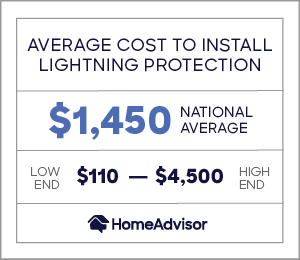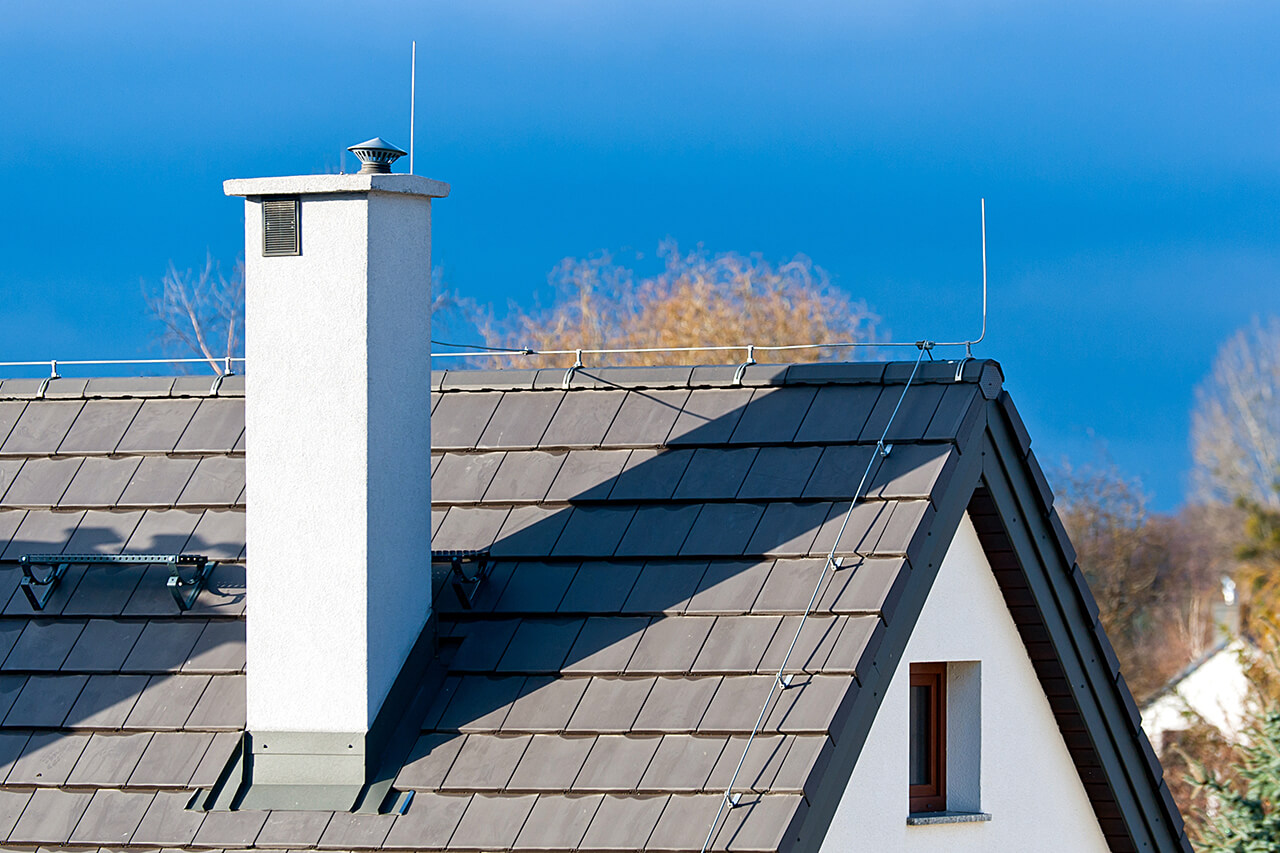How Much Does it Cost to Install a Home Lightning Protection System?
Typical Range:
$442 - $2,663
Typical Range:
$442 - $2,663
Cost data is based on actual project costs as reported by 884 HomeAdvisor members. Embed this data
.
.
.
.
.
.
.
.
.
.
.
.
.
.
.
.
.
.
.
.
.
.
.
.
.
.
.
.
.
.
•
•
•
•
Published January 10, 2022
Written by HomeAdvisor.Installing lightning protection systems in the home costs between $442 and $2,663, averaging most homeowners $1,552. The cost ranges from $100 for just a surge protector to over $3,000 for rods and grounding system.
A single lightning bolt is hotter than the surface of the sun. It carries 300 million volts of electricity - enough to wreak havoc on the average 220-volt home. In fact, one in 200 homes is hit by lightning each year, according to the National Lightning Safety Institute. Some are at greater risk depending on their size, height and surroundings (e.g. storm-prone areas, waterfront, flatlands and mountaintops).
A severe lightning strike can cost thousands to repair or replace a home’s structure, electrical wiring, appliances and electronics. To prevent this, a protection system uses lightning rods, a grounding system and surge protector to safely redirect electrical current away from the house.
Let's calculate cost data for you. Where are you located?
Where are you located?
| National Average | $1,552 |
| Typical Range | $442 - $2,663 |
| Low End - High End | $111 - $5,000 |
Cost data is based on actual project costs as reported by 884 HomeAdvisor members.
A lightning protection professional would typically charge $2,000 to $4,000 to install rods and a grounding system. Expect to pay between $60 and $2,500 per rod, with simple rods being on the lower end and an early streamer emission air terminal on the higher end. The cost depends on the selection of material (copper vs. aluminum), the type, and the size of your home and roof. The Lightning Protection Institute stresses the importance of hiring a UL-certified professional so your system is properly set up and meets national safety standards.
These rods were invented by Benjamin Franklin to protect vulnerable structures from electrocution. These copper or aluminum rods attach to the roof of a house or other structure, including trees. Your roof's size determines the number needed for thorough protection.
When lightning hits the rod, a grounding system (or earthing system) carries the electrical current to the ground, where it's harmlessly absorbed. Grounding systems are comprised of a specific electrical conductor/cable that runs from the rod, along the side of the house and into the ground. The cable attaches to a copper-clad grounding rod planted at least 10 feet below the earth's surface and two feet from the home.
There are two main types to choose from: simple and early streamer emission air terminals.
Lightning or Franklin rods are simple in form, low in price at $60 to $150, and most commonly used. Consult your lightning professional to determine if copper or aluminum rods are right for your home.
Copper: $125-$150 each with installation
Aluminum: $60-$75 each with installation
They are on the smaller side, so a house of 3,000 square feet could need six to seven to protect the entire structure. This results in various rods visibly protruding from the roof, which can be off-putting to some homeowners.
While it's recommended a professional afix these rods, a homeowner can easily replace them as needed. Simply screw the replacements into the mount affixed to the roof.
ESE air terminals are more expensive and much harder to install than their simple counterparts. They can cost $2,000 to $2,500 for the rod and professional set-up.
These terminals are taller, high-tech models that protect a larger surface area. It could prevent the need for multiple rods. Offered in electronic and non-electronic models, they work by emitting ionized particles that channel an eventual lightning strike. To do so, the tip of it should be at least 6.5 feet above the highest nearby building; a mast could be needed to reach that height.
Though lightning rod installation could be a DIY project, it's easier and safer to leave the work to a UL-certified professional. At the very least, he/she should assess how many rods you need and where they should be placed. If done on your own, you could spend $1,200 to $3,000 in DIY materials, including the rods, mounts, conductors, cable connectors, fasteners, and a grounding piece. When you buy a lightning protection system from a professional, all the equipment and labor are included as a packaged deal. This makes it difficult for a pro to install only parts of the overall system.
DIY-ers can purchase this equipment online and in select hardware stores. When purchasing on your own, you run the risk the equipment doesn't meet national safety standards.
A whole-house protector, including materials and installation, costs $300 to $500. They prevent the home from taking on excess voltage that can harm wiring, appliances and devices. This piece of equipment is built into the home's electric service panel and can cost $100 to $300 when purchased from a hardware store. Installation requires handing electrical components, so it's a job for an electrician or lightning protection company.
Each electronic should have its own plug-in or power strip, which can cost $20 to $50 each. A 110-volt surge protector is recommended for electronics like a TV and cable box. Most homeowners can install outlet surge protectors on your own.
It's important to know that a surge protector device (SPD) will sacrifice itself to do its job. You'll need to replace it if there's a surge of electricity. As a result, it's not necessary to spend money on the more expensive models. More money doesn't necessarily mean more protection. Just be sure the SPD you choose is UL-certified and doesn't have a history of causing fires.
A lightning arrester is an added line of defense to protect the home from lightning that strikes a power or communication line. It prevents power surges and outages. Arresters are above 1,000 volts and are affixed on power and telecommunication lines. Their job is to divert the current from the struck line to the ground, away from the house. Contact your local power or telecom company to inquire about the possibility of them installing them on power systems near your house.
According to the Insurance Information Institute, insurance companies pay more than $800 million in over 100,000 lightning-related claims per year. That translates into more than $8,000 per claim, which can include fire damage, structural damage, electrical repairs, and appliance and device replacements. It can also account for new landscaping in the case trees and plants were damaged.
Beyond defending the home and people in it, a protection system can provide peace of mind. If you've decided this system is right for you, talk to various qualified professionals and get multiple quotes. This will help you determine who will provide the best protection for your house.

